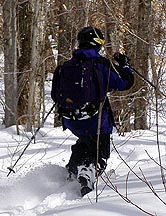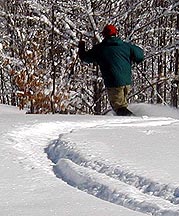
Skiing in the Whites
Skiing terrain in the Whites varies from steep, narrow chutes dropping into the Great Gulf to mellow, rolling tours through the Pemi Wilderness. There are a lot of options out there and there's something for nearly everyone. Obviously, snow and weather will dictate a lot of what is suitable for an adventure, but if you keep your eyes on the snow report and can get out of work soon after the flakes fly, you can be rewarded with an excellent time.
Backcountry skiing requires participants to have sufficient skills, gear, and training for it to be a safe activity. When out in the woods you are responsible for your own safety and ability to survive if an accident occurs. Do not rely on cell phones or other skiers for your well being. Nothing on this site should be considered instruction.
Where to Ski?
Tuckerman Ravine
The most recognizable place for backcountry ski adventures is Tuckerman Ravine on Mt Washington. It is a spring ritual, when thousands of hearty and sometimes crazy individuals head up to the Bowl to either test themselves against the steep runs, get their legs under them on the more gentle terrain lower down, or just soak in the scenery from the Lunch Rocks. Make no mistake, the Headwall and Gullies are quite steep, this is not something to be taken on lightly. You'll be carrying all your gear up for 2+ hours just to get to the base of the Ravine. From there you have to kick steps up a steep and often icy boot ladder, put on your gear on the side of a cliff, then take that first turn into the open air. It can be a lot of fun, but it's also very dangerous at times. Avalanche Danger is a real threat; read the avy report and listen to the snow rangers. Ice fall from the cliffs makes for quick reflexes on the Lunch Rocks. Ski season in the ravine are usually in the spring, from April to June, when the conditions are the best and avalance danger is the lowest.

Washington Beyond Tuckerman
There is more terrain on Washington that is challanging, but is more remote and isolated. While Tuckerman Ravine is still in the backcountry, there are almost always other people there, as well as the Snow Rangers who can often organize rescue or evacuation. Once you leave Tuckerman you must be self-sufficient. There are no avalanche forecasts beyond Tuckerman and Huntington, so you should have a good idea of what you are doing and how to determine avalanche dangers.
There are a series of large ravines on the Washington Massif. The ones with the best skiing besides Tuckerman are Gulf of Slides, Oakes Gulf, and the Great Gulf. All are remote and require some route finding and avy skills, as well as the ability to ski difficult terrain in sometimes sketchy conditions. All are best in spring when the snow softens and the days lengthen.
Pinkham Notch
There are a series of ski trails around Pinkham Notch that don't get as much use as they diserve. Avalanche Brook runs from Pinkham down to the Dana Place Inn, a rolling climb then thrilling descent that runs 5.6 miles. Connie's Way, the Old Jackson Road, and the Auto Road make a challanging loop to the north. There are a series of trails known as the Hayes Copp trails north of Pinkham at the Dolly Copp area. Finally, the Wildcat Valley Ski trail runs from the summit of Wildcat down to the trails of the Jackson Ski Touring Center. You can buy a single run lift pass at Wildcat and a Jackson X-C pass at the Wildcat base and then run down and back to your car at Jackson or loop on the Hall's Ledge trail back to Rt 16.

Moosilauke
Dartmouth College owns most of the land on and around Moosilauke and have build the trails there with skiing in mind. The major routes the Carriage Road, Gorge Brook, and Snapper trails, but you can also get some runs on the summit snowfields if the conditions cooperate. The Ravine Road which goes to the Moosilauke Ravine Lodge is gated in winter so you have to park at the plowed area on Rt 118 and ski the 1.5 miles to the summer trailhead. In addition to the routes up the mountain there is the Al Merrill Ski Loop on the Blue Ridge side of the ravine. It's a 5 mile loop over mostly logging roads but offers a nice descent if you do the loop counter clockwise.
Cardigan
From the AMC Cardigan Lodge there is a network of ski trails to enjoy that range from rolling tours to fun descents. Two of the most popular are the Alexandria and Duke's ski trails and they make for a fine skin up and ski back down.
Greeley Ponds
Nanamocomuck Ski Trails
Pemi
Zealand
Garfield and Beaver Brook
Vermont
Gear
Maps and Books
Backcountry Skiing Adventures by David Goodman
The best book for learning about backcountry ski (and snowboard) trips in the NH and Maine is "Backcountry Skiing Adventures" by David Goodman. It's money well spent. There are two volumes, one for NH and ME and the other for VT and NY.
Winter Trails Map - AMC
A good overview map of the main skiing trails in the White Mountain National Forest with trail descriptions. On Tyvek, this is very useful to have on any trip. Available here.
Ski Videos
These are videos from New England Telemark Festivals and other ski trips I've taken over the past few years:- Gulf of Slides
- Cardigan Dukes and Alexandria Trails
- Heather Paul Telemark Workshop
- 2008 NET Reggae Party at Bretton Woods
- 2008 NET Sunday River Telemark Festival
- Powder day somewhere in NH
- Powder day somewhere in VT
- Cannon and Mittersill NH
- NET 2007 Season Review
- NET Reggae Party at Bretton Woods, 3/24/07
- NET Sunday River Telemark Festival, 2/24/07
- NET Stowe Telemark Festival, 2/10/07
- Bretton Woods powder day
- December Powder in Utah, Dec 2006
My Trip Reports
- October skiing at Cannon - 29/Oct/2005
- Gulf of Slides: Corn Harvest - 9/Apr/2005
- Vermont Backcountry - 15/Feb/2004
- New Hampshire Backcountry - 07/Feb/2004
- Cardigan - 9/Mar/2003
- Moosilauke Carriage Road - 8/Mar/2003
- Garfield - 18/Jan/2003
- MLK weekend at Moosilauke, 2002
- Some skiing in Vermont
- Moosilauke Gorge Brook, yet, yet again
- Tuckerman Ravine: Right Gully and Snowfields
- Gulf of Slides
- Greeley Ponds daytrip
- MLK weekend at Moosilauke
- Moosilauke Gorge Brook, yet again
- Moosilauke Carriage Road, yet again
- Moosilauke Carriage Road
- Moosilauke Gorge Brook trail
- Tuckerman Ravine: Left Gully and Chute
Backcountry Skiing Links
- Telemark Tips - best tele site around
- North American Telemark Organization
- Tuckerman Volunteer Ski Patrol
- New England Ski Museum
- Catamount Ski Trail
- Time for Tuckerman
- Cyberspace Snow and Avalanche Center
- rec.skiing.backcountry FAQ
- Couloir Magazine
- Backcountry Ski Picture Page
- Build Yourself an Arctic Sled
- Telemark Skiing Injury Study
- Somewhere Out There
- Tuckerman rip Report
- X-C Skiing in NH from GORP
- First Tracks
- New England Lost Ski Area Project
- Alpine Zone
- Snow Journal
- First Tracks
Ski Areas
- Jackson Ski Touring Center
- Great Glen Trails
- Bear Notch Ski Touring Center
- Loon Mountain
- Wildcat
- Cannon Mountain
- Attitash Bear Peak
- Black Mountain
- Mount Sunapee
- The Balsams
- Bretton Woods
- Mt Washington Valley Sk Touring
- Waterville Valley
- The Balsams
- Tenney Mountain